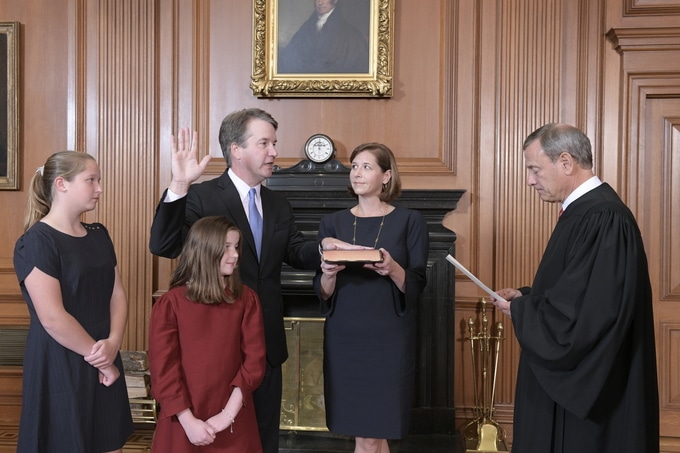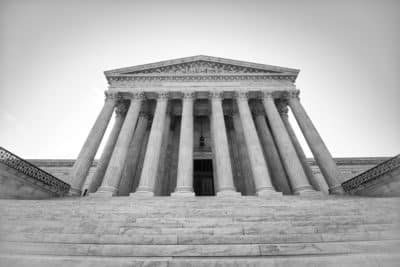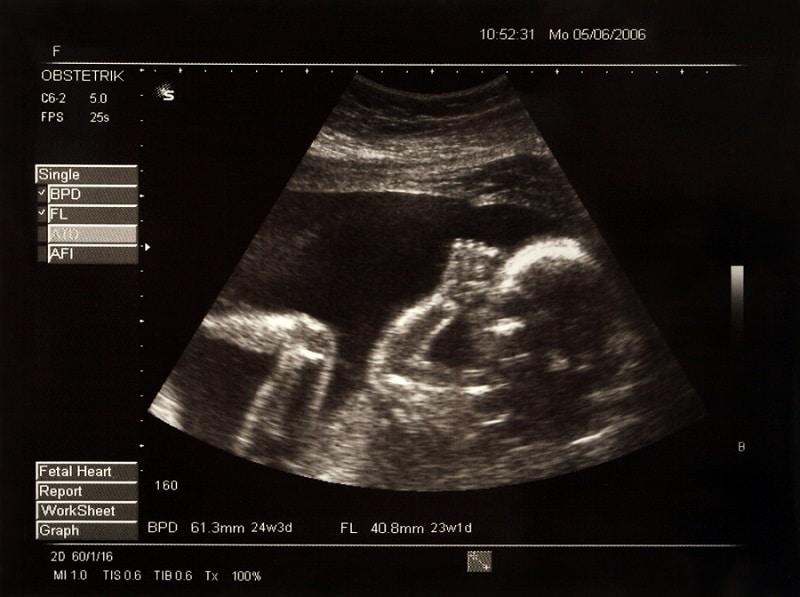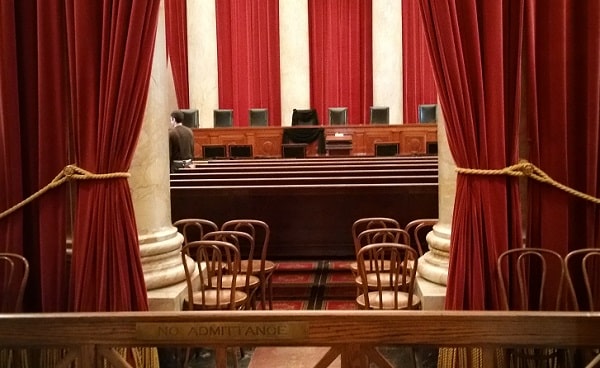The debate over the nomination of Brett Kavanaugh to the Supreme Court to replace Justice Anthony Kennedy has raised questions as to how his confirmation would affect the right to abortion recognized in Roe v. Wade. Some on the left claim that Justice Kavanaugh would provide the decisive vote to overrule Roe. Others, like Senator Susan Collins (R-Maine) supported Kavanaugh, in part, because she believes he will not vote to overturn Roe, largely because of his respect for doctrine of stare decisis (following precedent). In her Senate floor speech the day before the confirmation vote, Senator Collins said the following:
Finally, in his testimony, he noted repeatedly that Roe had been upheld by Planned Parenthood v. Casey, describing it as “precedent on precedent.” When I asked him would it be sufficient to overturn a long-established precedent if five current justices believed it was wrongly decided, he emphatically said “no.”
We posed several questions to Texas Alliance for Life’s special counsel Paul Benjamin Linton about the proper role of precedent and stare decisis and how Justice Kavanaugh might be guided by those principles.

Q: Does the United States Constitution protect a right to privacy and, if so, to what extent does that right provide a basis for the right to abortion in Roe and Casey?
A: The Constitution does not contain an express right to privacy, although certain provisions of the Bill of Rights may be said to protect aspects of privacy. For example, the Fourth Amendment secures the “right of the people to be secure in their persons, homes, papers and effects, against unreasonable searches and seizures,” and the Fifth Amendment protects the right of a criminal defendant not to incriminate himself.
The first case to recognize an implied right of privacy, as such, was Griswold v. Connecticut (1965), in which the Supreme Court struck down a Connecticut statute prohibiting the use of contraceptives by married persons. Griswold was followed a few years later by Eisenstadt v. Baird (1972), which held that the State could not bar the use of contraceptives by unmarried persons. Conceptually, Griswold should be classified as a case decided under the Due Process Clause of the Fourteenth Amendment, while Eisenstadt is more properly regarded as an Equal Protection Clause case (the State may not validly distinguish between married couples and unmarried couples in the use of contraceptives). Notwithstanding the Court’s invocation of privacy theory in Griswold, only two years later, in Katz v. United States (1967), the Court refused to recognize a generalized right of privacy.
In Roe v. Wade (1973), the majority opinion written by Justice Blackmun recognized a right to abortion, deriving it from a group of largely unrelated cases (addressing the right to send children to parochial schools and to educate them in a language other than English, the right of persons not related to each other to live in a common household, the right to refuse unwanted medical treatment and the right to use contraceptives) which the Court characterized as recognizing a right to privacy, even though privacy theory was not mentioned in any of those cases other than Griswold and Eisenstadt (which was decided while Roe was under consideration by the Court).

Subsequent to Roe, however, the Court has backed away from privacy theory, preferring, instead, to evaluate unenumerated rights (that is, rights not expressly guaranteed by the Constitution) under the express liberty language of Section 1 of the Fourteenth Amendment, which prohibits any State from depriving any person “of life, liberty, or property, without due process of law . . ..” For example, in Cruzan v. Director, Missouri Department of Health (1990), the Court refused to evaluate an asserted right to refuse unwanted medical treatment under the rubric of a “generalized constitutional right of privacy,” stating that such a right “is more properly analyzed in terms of a Fourteenth Amendment liberty interest.”
Although asserted privacy interests certainly informed the Court’s decisions recognizing a right to engage in noncommercial homosexual sexual activity in private between consenting adults, Lawrence v. Texas (2000), and a right of same-sex couples to marry, Obergefell v. Hodges (2016), neither case rested upon a right of privacy, but, instead, were based on the liberty language of the Due Process Clause. The same can be said of the Court’s decision in Planned Parenthood v. Casey (1992), reaffirming, in part, Roe v. Wade.
In his confirmation hearing, Judge Kavanaugh expressed no disagreement with the body of case law from which the Court in Roe derived a right to abortion (he declined to state whether Roe should be reconsidered, merely accurately describing Roe as a long-standing precedent which has been reaffirmed by the Court on several occasions). Overruling Roe, however, would not require reconsideration of any of those cases, all of which (other than the contraception cases) have little or nothing to do with abortion.
In reaffirming Roe, as modified, in Planned Parenthood v. Casey (1992), the Court recognized that “abortion is a unique act,” 505 U.S. at 852, that “one could classify Roe as sui generis,” id. at 857, and that “Roe was, of course, an extension of those cases,” id. at 853 (emphasis added), referring to cases “granting protection to substantive liberties of the person.” Id. And even with respect to the Court’s contraception cases (Griswold, Eisenstadt), overruling Roe would not require reconsideration of those cases. In Casey, the Court said that “Roe’s scope is confined by the fact of its concern with postconception potential life, a concern otherwise likely to be implicated only by some forms of contraception protected independently under Griswold and later cases . . . .” Casey, 505 U.S. at 859 (emphasis added). In sum, Justice Kavanaugh’s acceptance of the body of case law on which Roe v Wade was decided would not preclude him for reconsidering Roe as a precedent.
Q: How has the Supreme Court historically treated precedent?
A: There is a general legal principle that decided cases should not be overturned, merely because a majority of the Court believes a particular decision to have been wrongly decided. This principle, or doctrine, is known by the Latin term, “stare decisis,” which is a short form of a longer Latin phrase, “stare decisis et non quiet a movere,” that is, let what is decided stand and do not disturb (move) what is at rest (what has been decided). This doctrine, which ultimately derives from the common law of England, has less force in the context of constitutional interpretation, where erroneous decisions can be overturned only by the cumbersome and time-consuming method of amending the Constitution.
The Joint Opinion in Casey gave the impression that overruling decisions are rare and to be avoided. That impression is very misleading. The Supreme Court has overruled its own decisions more than 230 occasions, and fully three-fourths of those overrulings concerned constitutional interpretation (as opposed to statutory interpretation).
The Supreme Court has overruled its own decisions more than 230 occasions, and fully three-fourths of those overrulings concerned constitutional interpretation (as opposed to statutory interpretation).
Indeed, at the end of its last Term, the Court overruled four of its earlier precedents on constitutional grounds. The Court, it must also be noted, has overruled its precedents upholding laws restricting marriage to opposite-sex couples and prohibiting homosexual sexual conduct.
In his conversation with Senator Collins, Judge Kavanaugh recognized Planned Parenthood v. Casey as a “precedent on precedent,” and acknowledged that a precedent could not be overturned merely because five justices thought it was wrongly decided. What is the significance of these statements?
Judge Kavanaugh correctly described Casey as a “precedent on precedent,” that is, a case that, in reaffirming an earlier opinion, set forth the factors that need to be taken into account in deciding whether to overrule a prior precedent. Those factors include whether the earlier precedent has proved to be workable in application; whether there are significant reliance interests that have been created as a result of the precedent; whether there has been an evolution of legal principle that has called into question the precedent; and whether the underlying facts supporting the precedent have changed.
As an initial matter, the Joint Opinion’s paean of praise in support of adhering to precedent in Casey simply ignores or overlooks the multiple respects in which Casey departed from Roe. In Casey, the Joint Opinion:
- Rooted the right to abortion in the liberty language of the Due Process Clause of the Fourteenth Amendment, rather than, as in Roe, any generalized “right of privacy”;
- Downgraded the nature of the right to abortion, never referring to it as a “fundamental right”;
- Abandoned the “strict scrutiny” standard of judicial review adopted in Roe in favor of the less burdensome and newly minted “undue burden” test;
- Discarded the trimester framework for evaluating abortion regulations;
- Gave greater weight to the State’s interests in regulating abortion throughout pregnancy; and
- Overruled, in part, two prior opinions, City of Akron v. Akron Center for Reproductive Health (1983) and Thornburgh v. ACOG (1986).
Given Casey’s departure from Roe’s analysis of the source of the abortion right and its nature, its repudiation of Roe’s standard of review and the trimester framework, its greater recognition of the State’s regulatory interests, and its overruling of two prior precedents, it is difficult to take seriously Casey’s reliance on principles of stare decisis for adhering to what it described as the “essential” or “central” holding of Roe, to wit, that the State may not prohibit a woman from obtaining an abortion prior to viability.
Even with respect to that holding, the Court in Casey acknowledged that (as of 1992) viability occurred three to four weeks earlier than it did when Roe was decided (1973) and, therefore, the State’s authority to prohibit abortion (subject to exceptions for the woman’s life or health) begins that much earlier in pregnancy. In any case in which the Court is asked to revisit Roe, Justice Kavanaugh would be fully aware of the multiple respects in which Casey departed from Roe. That weakens both Roe as a precedent and Casey as a “precedent on precedent.”

A detailed examination of the factors on the basis of which the Court might reconsider and overrule an earlier precedent (in addition to the belief that the precedent was wrongly decided) lies outside the scope of this analysis. Suffice it to say that, notwithstanding the Joint Opinion’s analysis of the stare decisis factors, Roe (and in particular, Casey’s reformulation of Roe) has not proved to be workable in practice:
- The reliance interests cited in Casey in favor of reaffirming Roe (as modified) are either illusory or depend on other legal rights accorded to women that would not be affected by an overruling decision;
- Roe’s (and Casey’s) analysis of unenumerated rights cannot be reconciled with Court’s later decision in Washington v. Glucksberg (1997), rejecting a right to physician assisted suicide;
- Roe’s understanding of the law regarding the status of the unborn child outside the context of abortion was not only a gross distortion of the law in effect at the time, but has been undermined by the dramatic expansion of fetal rights in other areas of the law, including criminal law (fetal homicide statutes), tort law (common law prenatal injury actions and statutory wrongful death actions), property law (inheritance), health care law (statutes restricting the removal of life-sustaining treatment from pregnant women), and guardianship law (statutes and rules allowing guardians to be appointed to represent the interests of unborn children outside the context of abortion); and
- Finally, there is no requirement that there must have been a “change in fact” to warrant reconsideration of an otherwise flawed decision.
In Janus v. AFSCME, decided last June, the Supreme Court overruled a forty-one-year-old precedent, Abood v. Detroit Board of Education (1977), on the constitutionality of withholding union dues (or agency fees) from government employees who object to having to pay such dues (or fees). In his opinion for the Court, Justice Alito carefully analyzed the multiple stare decisis factors that must be considered in deciding whether to overrule an earlier precedent. The stare decisis analysis in Janus, applied to Roe, would likely yield a similar result, that is, the precedent should be overruled.
Q: Can we expect Roe v. Wade to be overturned in the near future?
A: Judge Kavanaugh properly refused to answer questions on whether Roe should be overruled. Would his accession to the Court provide the fifth vote to overrule? That is doubtful. Only one justice currently on the Court — Clarence Thomas — has voted to overrule Roe. Based upon his judicial philosophy and published opinions, Justice Alito very possibly would be willing to overrule Roe in an appropriate case, as might Justice Gorsuch.
Chief Justice Roberts is another matter. The Chief Justice’s opinion upholding the Affordable Care Act gives one pause, as does his (in my view) exaggerated respect for precedent (which, to some extent, may be shared by Justice Kavanaugh). Although the Chief Justice might be willing to join an opinion overruling Roe at some point, it is doubtful he would cast the decisive (fifth) vote, particularly in the absence of further erosion of Roe. In other words, if his vote were needed, it is unlikely that it would be obtained.
Although the Chief Justice might be willing to join an opinion overruling Roe at some point, it is doubtful he would cast the decisive (fifth) vote, particularly in the absence of further erosion of Roe.
That makes Justice Kavanaugh’s views on abortion academic, at least until there is another vacancy on the Court, because he would constitute, at best, the fourth vote, not the fifth and decisive vote. My sense is that Judge Kavanaugh, as well as Chief Justice Roberts and Justices Thomas, Alito, and Gorsuch, would likely uphold virtually any reasonable regulation of abortion, short of a prohibition before viability, and also would likely uphold a fairly narrow post-viability ban.

What I do not think that the Court (with Justice Kavanaugh) would do is uphold a statute directly conflicting with Roe, for example, a “heartbeat” ban or a ban on an abortion procedure that would in effect be a ban on second-trimester abortions, such as the dismemberment bills that have been struck down or enjoined wherever they have been enacted.
What would make more sense would be to “take the Court’s temperature” on abortion statutes it has not considered, for example,a post-viability ban with a narrow physical health exception. Would a reconstituted Court be willing to reconsider the Hellerstedt opinion regarding abortion facility safety standards? And there are other options.
Until we know more on where the Chief Justice and Justices Alito, Gorsuch, and Kavanaugh stand on Roe, which can best be learned from taking regulatory cases to the Court, we must proceed with caution, not risking a premature direct challenge to Roe when we lack the votes to overrule it. A premature challenge to Roe could force the anti-Roe justices on the Court to “show their hand” before there are five votes to overrule, thus creating bad precedent, making confirmation of a fifth anti-Roe justice more difficult, and resulting in a massive attorney fee award in favor of Planned Parenthood or other abortion providers.
Paul Benjamin Linton is an attorney in private practice who specializes in state and constitutional law, legislative consulting, and scholarly writing. Mr. Linton has submitted scores of briefs on beginning-in-life and end-of-life issues in the United States Supreme Court, the lower federal courts, and most of the state supreme courts in the country. He has published twenty law review articles on a variety of topics, including the history of abortion regulation, criminal law, physician-assisted suicide, religious freedom claims and defenses under state constitutions and sex discrimination. He has published many articles in journals of opinion, as well as the only full length treatment of abortion under state constitutions, the third edition of which will appear early in 2019. He received his undergraduate degree (B.A. Honors in History) and law (J.D.) degrees from Loyola University of Chicago.